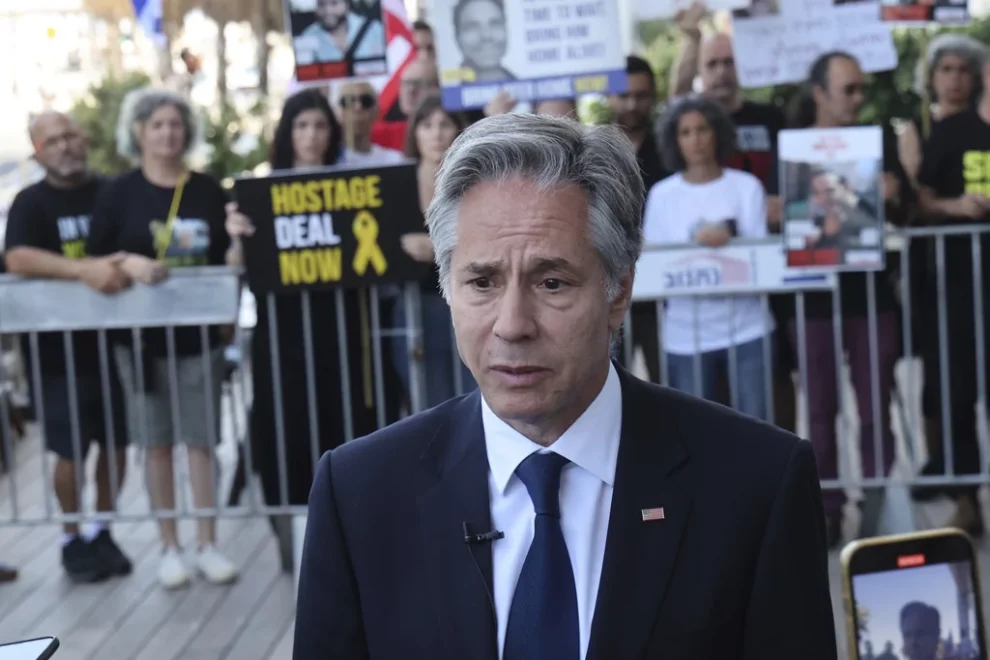The Biden administration is aiming to see Israel and Hamas agree to a ceasefire deal by the end of next week after negotiators made significant progress this week in Doha, Qatar.
U.S., Egyptian, and Qatari leaders met in Doha on Thursday and Friday and discussed the latest proposal with the Israeli and Hamas sides. The meetings, according to a senior Biden administration official, “probably were the most constructive 48 hours that we’ve had in this process in many months.”
These leaders will meet “again in Cairo before the end of next week, we will gather again at this level with an aim to conclude this. That is the goal,” the official added. “This is kind of the final stage, end game of the process.”
Mediators have gone back and forth with various proposals for several months to try to get both Israel and Hamas to agree to a deal that would include the release of the Israeli hostages kidnapped by Hamas on Oct. 7 and a surge of humanitarian aid allowed into the Gaza Strip for civilians desperately in need.
“We’re much, much closer than we were three days ago,” President Joe Biden told reporters in the Oval Office on Friday.
“I don’t want to jinx anything,” he added, saying the deal is not done yet, but “we’re close.”
Biden spoke with Amir Sheikh Tamim Bin Hamad al Thani of Qatar and separately spoke with President Abdel Fattah al Sisi of Egypt on Friday to discuss the progress negotiators made during the two days of discussions.
Secretary of State Antony Blinken will travel to Israel on Saturday to continue the diplomatic efforts to get the deal over the finish line.

Should all sides get this agreement completed, it would end the most destructive iteration of fighting between Israel and Hamas. The Gaza Strip has been decimated, nearly the entire population has been displaced and faces hunger and sanitation concerns, and the Hamas-controlled health ministry said this week that more than 40,000 people have been killed, though that total does not distinguish between civilians and combatants.
The Israel Defense Forces have killed 17,000 Hamas fighters, Rear Adm. Daniel Hagari, an IDF spokesman, said this week. Hamas intentionally lives and operates within civilian communities and in tunnels underneath those areas, using the people as human shields, with the intent of having Israeli operations incur civilian deaths and injuries.
Israeli forces have killed several of Hamas’s top leaders, and the last remaining primary orchestrator of Hamas’s Oct. 7 attack, Yahya Sinwar, is believed to be hiding in tunnels far below the surface of Gaza.
Biden laid out the framework for a deal on May 31 and added, at the time, that there were still hurdles to overcome but that the framework was ready to be advanced past the finish line. Israel proposed a deal on May 27, which was the basis for the Biden publicized speech days later.
More than a month later, on July 3, Hamas came back with a response that included “a number of changes, many of which were not acceptable,” the official added.
Israel further clarified their proposal on July 27.
As of the conclusion of the talks Friday, mediators have now put down bridging proposals from where both sides currently stand to cover every matter in these negotiations, the official said.
Mediators are hoping that a ceasefire deal between Israel and Hamas could simmer escalating tension in the region, primarily between Iran and its proxies against Israel. Iranian leaders have vowed to avenge the assassination of Hamas political bureau leader Ismail Haniyeh, who was murdered in Tehran.
Hamas ignited the current conflict on the morning of Oct. 7, when thousands of terrorists overwhelmed the border fence and went through local southern Israeli communities, killing roughly 1,200 people and kidnapping about 250 others. It was the largest terrorist attack in Israel’s history.
About half of the hostages were released during the weeklong ceasefire in late November, but Hamas has not released any of the others since, though a handful have been rescued during Israeli operations. It’s unknown how many of the hostages are still alive. Five Americans are believed to be alive in Gaza.
Hezbollah, similar to Hamas, is one of Iran’s proxies and has exchanged rocket and missile cross-border attacks since shortly after Hamas’s Oct. 7 attack that ignited the current conflict. Lebanese Hezbollah is considered a much larger terrorist group and is believed to have a much more robust arsenal.
CLICK HERE TO READ MORE FROM THE WASHINGTON EXAMINER
It’s unclear what Iran’s response could look like, but the official warned, “The consequences could be quite cataclysmic, particularly for Iran.”
U.S. leaders have publicly and privately warned Iran not to attack Israel. The U.S. military has increased its presence in the region to aid Israel if an attack were to occur.
























